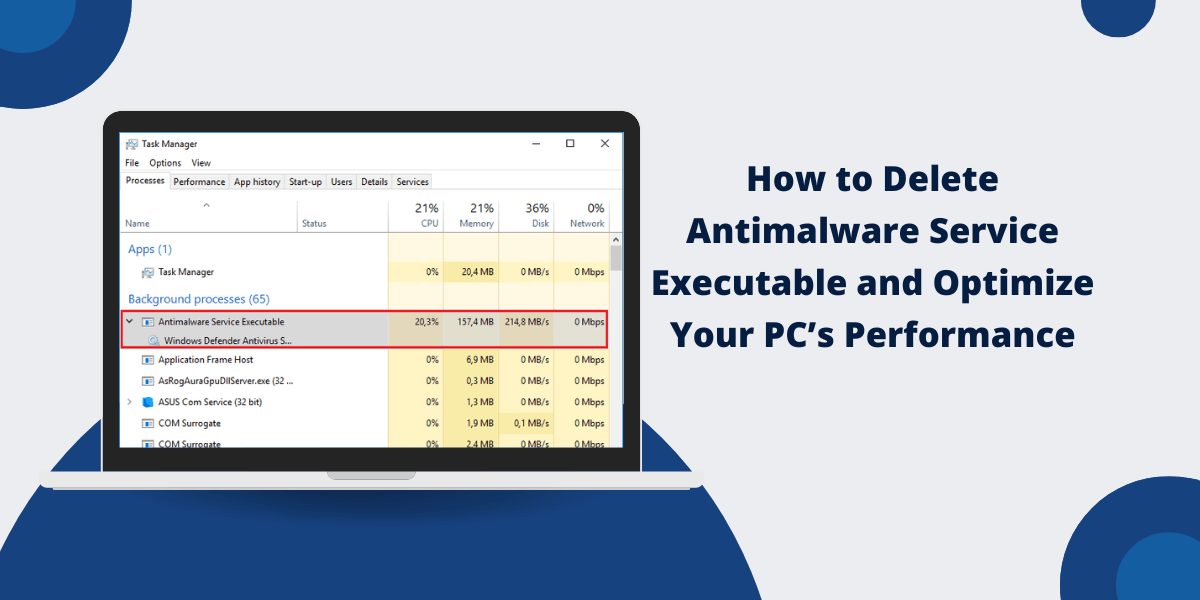The Antimalware Service Executable is a central process for Windows Defender, which is the Microsoft built-in antivirus software. Although this is an excellent tool to resist malware on your PC, it can slow down your computer since it is resource demanding.
If it is slowing down your PC or causing high CPU usage, you are perhaps thinking of disabling the Antimalware Service Executable or maybe reducing its impact on your system.
What is the Antimalware Service Executable?
Antimalware Service Executable or MsMpEng.exe, serves as the core process of Windows Defender. It works in the background to perform a scan of your system for malware, viruses, and other threats.
While this certainly makes it important for your system security, it could consume, at times, too many CPU and memory resources while doing its work.
Why Would You Want to Delete Antimalware Service Executable?
It is not recommended to remove Antimalware Service Executable as it deactivates Windows Defender; however, there are good tempers for a selected management.
- High CPU Usage: The procedure His Excellency was recently overheard practicing 50-100 percent usage of the CPU.
- Scheduled Scans: Windows Defender scans regularly and may interfere with any active work.
- Use of Th-Class: If you are using any other class of antivirus, Windows Defender may cause conflicting situations.
How to Delete Antimalware Service Executable Temporarily
If you’re looking to remove Antimalware Service Executable temporarily, follow these steps:
- Disable Real-time protection
- Scheduled Scans
- Group Policy Editor(Only for Windows Pro/Enterprise)
1. Disable Real-time protection
- Open the Windows Security
- Go to Virus & Threat Protection.
- Click the settings management under Virus and Threat Protection Settings.
- Turn off Real-time Protection.
Note: This will stop it from running temporarily.
2. Scheduled Scans
- Open Task Scheduler by searching for it in the Start menu.
- Go to Task Scheduler Library > Microsoft > Windows > Windows Defender.
- Look for Windows Defender Scheduled Scan
- Right-click and select Disable to stop the automatic scans.
3. Group Policy Editor(Only for Windows Pro/Enterprise)
- Press Win + R, type msc and hit Enter.
- Go to Computer Configuration > Administrative Templates > Windows Components > Microsoft Defender Antivirus.
- Double-click to Turn off Microsoft Defender Antivirus to Enable.
How to Permanently Remove Antimalware Service Executable
Though Antimalware Service Executable cannot be completely uninstalled since it is part of the Windows Defender; disabling it will result in your computer being left open to attacks from different malware. If you’re running other antivirus programs and want to uninstall Antimalware Service Executable completely, follow these steps for complete uninstallation:
- Uninstall Windows Defender via Registry Editor
- Use Third-Party Tools
1. Uninstall Windows Defender via Registry Editor
- Press Win + R, type regedit, and hit Enter.
- Navigate to:
HKEY_LOCAL_MACHINE\SOFTWARE\Policies\Microsoft\Windows Defender
- Right-click on the right pane, select New > DWORD (32-bit) Value, and name it DisableAntiSpyware.
- Set its value to 1.
- Restart your computer.
Warning: Editing the registry can cause system instability if not done properly. Do so at your own risk.
2. Use Third-Party Tools
Other third-party tools like Defender Control or O&O ShutUp10 can help you disable Windows Defender permanently.
Alternatives to Deleting Antimalware Service Executable
If removing Antimalware Service Executable isn’t your chosen option, here are some useful alternatives available:
- Add Exclusions: These are files, folders, and processes that need not be scanned by Windows Defender so that it minimizes the scanning load.
- Upgrade Your Computer: If your machine is quite old as in the CPU-or you could add RAM, this can solve the problem as such resource-intensive processes.
- Consider Using a Lightweight Antivirus: If Windows Defender is too heavy for your system, it would be best to consider changing it to some lightweight third-party antivirus software.
Final Thoughts
It’s obvious that Antimalware Service Executable, while very important for system needs, can also slow your system down. Know-how to either delete Antimalware Service Executable or control its effect might better optimize your PC performance. That’s permanently out if, of course, you don’t have an additional reliable antivirus solution in place.
If you implement the above-mentioned steps, you’re going to exploit all of your system-scale resources while you’re not losing the promise value of security. Or otherwise, if you’d like, just go ahead and remove Antimalware Service Executable, or just tweak its settings; your PC will surely thank you for that.

Priya Mervana
 Verified Web Security Experts
Verified Web Security Experts
Priya Mervana is working at SSLInsights.com as a web security expert with over 10 years of experience writing about encryption, SSL certificates, and online privacy. She aims to make complex security topics easily understandable for everyday internet users.



